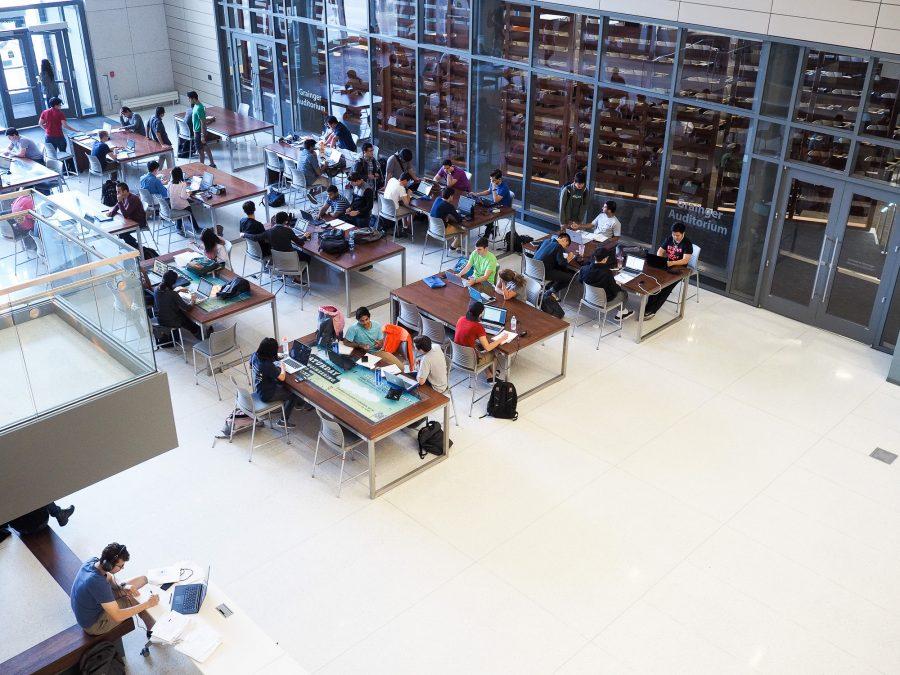UI to increase enrollment by 20 percent through online master’s programs
Students study in the Electrical and Computer Engineering Building in Champaign, IL. October 4, 2016.
Oct 12, 2016
An increase in online degrees could help the University system increase the number of overall degrees awarded by 20 percent within the next six years.
University President Timothy Killeen asked the three campuses to develop plans for 10, 15 and 20 percent growth over the next six years. But a committee of 13 faculty members decided to only make plans for a 20 percent increase because they wanted to aim high.
Charles Tucker, vice provost for undergraduate education and innovation, said the campus has grown one percent per year for several decades, mostly at the undergraduate level. He attributes most of the growth to increasing numbers of each freshman class.
But the campus is reaching capacity for undergraduate resident enrollment, he said. Residence halls could hold more students for the next few years, but soon Illinois Street Residence Hall will undergo remodeling and make it harder to enroll a larger class. Due to this restriction, future growth must come through master’s degrees or online programs, Tucker said.
The committee’s overall goal was to maximize institutional impact for the state of Illinois in a way that is financially sustainable, he said.
Get The Daily Illini in your inbox!
“We think of impact as the product of excellence and size,” he said. “So, you could have the very best student in the world, but if there is only one of her, you’re not making as much of an impact or if you are a giant university but not producing very high quality students, you are also not making a good impact.”
Instead, he said the campus must grow only where it makes sense and should focus on enrolling a high-potential group of diverse students.
The overall student body, at 44,880, has Illinois ranked as the seventh largest public university in the country. Of the University’s peer groups, only the University of Texas at Austin is larger.
Online or graduate programs for business, information sciences, engineering, media, social work and the Carle Illinois College of Medicine could increase enrollment by more than 6,300 students, he said.
Tucker said there is a lot of interest in online degree programs and the committee saw that there were over 11 programs currently enrolling students or being planned for Fall 2017.
At a Senate Executive Committee meeting on Oct. 3, Tucker said the committee found that the college’s interest in master programs is enhanced because of the way the University allocates tuition.
“As we enter a period of budget reform, there is a broad sense that we have tended to tax undergraduate tuition fairly heavily and graduate tuition less so,” he said. “I think there will be a lot of robust discussion on if we’d like to balance that a little bit.”
During Monday’s Academic Senate meeting, the question of lowering tuition came up when talking about financial aid. Students’ unmet financial need has doubled over the last decade, increasing from $43 million in 2005-2006 to $109 million last year.
Associate Professor Bruce Rosenstock said the University’s tuition is among the highest in the Big Ten and encouraged lowering it. Killeen has said he hopes to freeze tuition again for the third consecutive year.
Rosenstock said Indiana and other Big Ten schools have cheaper out-of-state tuition rates than the in-state rates at Illinois. Tucker said that out-of-state rates at other Big Ten schools are more expensive for students. For example, out-of-state tuition for Indiana costs $34,246 and in-state tuition for Illinois ranges from $15,698-$20,702. However, other Big Ten schools are able to offer scholarships that make rates similarly priced.
Of the top 10 reasons why students do not decide to attend Illinois, eight are due to finances, stating that the costs were too high or they didn’t receive as much aid as other universities provided, according to the Office of the Provost.
Rosenstock asked why the school won’t make lowering costs one of its top goals.
“Why can’t it be part of our commitment over the next 10 years to lower tuition? We must take the lead and make this a priority and a commitment,” he said.
But the University is already at a $190 million shortfall in its budget because of the state impasse.
Departments manage doctoral enrollments against their needs for research or teaching assistance, or for financial resources for fellowship support, Tucker said.
Professor Nicholas Burbules questioned how long the University can continue to hire doctoral students because while the campus needs them for research and teaching assistance, the job market for them is drying up.
He asked at what point should the university ask if they are taking advantage of students by giving them the expectation they will get their Ph.Ds and join the faculty, while many of them won’t end up doing so. Tucker said the committee didn’t grapple with that, but it is a significant concern.
The enrollment committee met regularly from November 2015 until the report was released in August. They had degree-granting units on campus to complete a survey describing their enrollment and limiting factors and challenges for each degree program.
[email protected]
@MeganAsh_Jones






